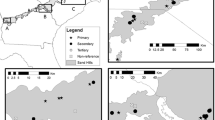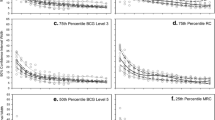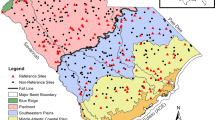Abstract
Our study develops and demonstrates an objective method for selecting reference sites for the assessment of ecological condition in freshwater ecosystems. The method uses widely available GIS data to group potential sites based on their natural environments. It then establishes the degree and types of human activities each site is exposed to prior to scoring the sites in each group by the relative amount of human activity present. Finally, the sites in each group with the least amount of human activity are categorized as reference sites, with the boundary between reference and test sites defined to maximize the distinctiveness of the two categories with respect to human activity. Application of this technique for the purpose of identifying headwater reference basins in rural areas of southwestern Ontario resulted in the classification of basins into six natural groups based on the dominant texture of the surface geology. Development of a human activity gradient indicated that basins varied according to the amount of exposure to agricultural activities with most basins having at least moderate exposure. Establishment of the reference test boundary indicated that the selected reference basins exhibited substantively lower extents of agricultural activity than test sites for most groups. Because this method uses only widely available GIS data, it enables rapid and cost-effective identification of candidate reference sites, even for large, remote, and understudied regions.
Similar content being viewed by others
References
Allan, J. D. (2004). Landscapes and riverscapes: The influence of land use on stream ecosystems. Annual Review of Ecology Evolution and Systematics, 35, 257–284.
Baattrupp-Pedersen, A., Kristensen, E. A., Jørgensen, J., Skriver, J., Kronvang, B., Andersen, H. E., et al. (2009). Can a priori defined reference criteria be used to select reference sites in Danish streams? Implications for implementing the water framework directive. Journal of Environmental Monitoring, 11(2), 344–352.
Bailey, R. C., Kennedy, M. G., Dervish, M. Z., & Taylor, R. M. (1998). Biological assessment of freshwater ecosystems using a reference condition approach: Comparing predicted and actual benthic invertebrate communities in Yukon streams. Freshwater Biology, 39(4), 765–774.
Bailey, R. C., Norris, R. H., & Reynoldson, T. B. (2004). Bioassessment of freshwater ecosystems: Using the reference condition approach. Boston: Kluwer Academic.
Bailey, R. C., Reynoldson, T. B., Yates, A. G., Bailey, J., & Linke, S. (2006). Integrating stream bioassessment and landscape ecology as a tool for landuse planning. Freshwater Biology, 52(5), 908–917.
Bryce, S. A., Larsen, D. P., Hughes, R. M., & Kaufmann, P. R. (1999). Assessing relative risks to aquatic ecosystems: A mid-appalachian case study. Journal of the American Water Resources Association, 35(1), 23–36.
Collier, K. J., Haigh, A., & Kelly, J. (2007). Coupling GIS and multivariate approaches to reference site selection for wadeable stream monitoring. Environmental Monitoring and Assessment, 127(1–3), 29–45.
Corkum, L. D. (1989). Patterns of benthic invertebrate assemblages in rivers of northwestern North America. Freshwater Biology, 21(2), 191–205.
Danz, N. P., Niemi, G. J., Regal, R. R., Hollenhorst, T., Johnson, L. B., Hanowski, J. M., et al. (2007). Integrated measures of anthropogenic stress in the U.S. Great Lakes Basin. Environmental Management, 39(5), 631–647.
Davies, P. E. (2000). Development of a national river bioassessment system (AUSRIVAS) in Australia. In J. F. Wright, D. W. Sutcliffe, & M. T. Furse (Eds.), Assessing the biological quality of fresh waters: RIVPACS and other techniques (pp. 113–124). Ambleside: Freshwater Biological Association.
ESRI (2005). ESRI ArcMap 9.1. Redlands, California.
Frissell, C. A., Liss, W. J., Warren, C. E., & Hurley, M. D. (1986). A hierarchical framework for stream habitat classification: Viewing streams in a watershed context. Environmental Management, 10(2), 199–214.
Hering, D., Buffagni, A., Moog, O., Sandin, L., Sommerhäuser, M., Stubauer, I. et al. (2003). The development of a system to assess the ecological quality of streams based on macroinvertebrates—Design of the sampling programme within the AQEM project. International Review of Hydrobiologia, 88(3–4), 345–361.
Herlihy, A. T., Paulsen, S. G., Van Sickle, J., Stoddard, J. L., Hawkins, C. P., & Yuan, L. L. (2008). Striving for consistency in a national assessment: The challenges of applying a reference-condition approach at a continental scale. Journal of the North American Benthological Society, 27(4), 860–877.
Hughes, R. M. (1995). Defining acceptable biological status by comparing with reference conditions. In W. S. Davis, & T. P. Simon (Eds.), Biological assessment and criteria: Tools for water resource planning and decision making (pp. 31–48). Boca Raton: Lewis.
Hughes, R. M., Larsen, D. P., & Omernik, J. M. (1986). Regional reference sites: A method for assessing stream potentials. Environmental Management, 10(5), 629–635.
Hughes, R. M., Paulsen, S. G., & Stoddard, J. L. (2000). EMAP-Surface Waters: A multiassemblage, probability survey of ecological integrity in the U.S.A. Hydrobiologia, 422/423, 429–443.
Hynes, H. B. N. (1975). The stream and its valley. Verhandlungen der Internationalen Vereinigung fur Theoretische und Angewandte Limnologie, 19, 1–15.
Infante, D. M., Allan, J. D., Linke, S., & Norris, R. H. (2009). Relationship of fish and macroinvertebrate assemblages to environmental factors: Implications for community concordance. Hydrobiologia, 623, 87–103.
Jenks, G. F., & Coulson, M. F. C. (1963). Class intervals for statistical maps. International Yearbook of Cartography, 3, 119–134.
Ode, P. R., Rehn, A. R., & May, J. T. (2005). A quantitative tool for assessing the integrity of Southern Coastal California streams. Environmental Management, 35(4), 493–504.
Reynoldson, T. B., & Wright, J. F. (2000). The reference condition: Problems and solutions. In J. F. Wright, D. W. Sutcliffe, & M. T. Furse (Eds.), Assessing the biological quality of fresh waters: RIVPACS and other techniques (pp. 293–309). Ambleside: Freshwater Biological Association.
Reynoldson, T. B., Norris, R. H., Resh, V. H., Day, K. E., & Rosenberg, D. M. (1997). The reference condition: A comparison of multimetric and multivariate approaches to assess water-quality impairment using benthic macroinvertebrates. Journal of the North American Benthological Society, 16(4), 833–852.
Reynoldson, T. B., Day, K. E., & Pascoe, T. (2000). The development of the BEAST: A predictive approach for assessing sediment quality in the North American Great Lakes. In J. F. Wright, D. W. Sutcliffe, & M. T. Furse (Eds.), Assessing the biological quality of fresh waters: RIVPACS and other techniques (pp. 165–180). Ambleside: Freshwater Biological Association.
Richards, C., Haro, R. J., Johnson, L. B., & Host, G. E. (1997). Catchment and reach-scale properties as indicators of macroinvertebrate species traits. Freshwater Biology, 37(1), 219–230.
Sandin, L., & Johnson, R. K. (2000). Ecoregions and benthic macroinvertebrate assemblages of Swedish streams. Journal of the North American Benthological Society, 19(3), 462–474.
Stoddard, J. L., Larsen, D. P., Hawkins, C. P., Johnson, R. K., & Norris, R. H. (2006). Setting expectations for the ecological condition of streams: The concept of reference condition. Ecological Applications, 16(4), 1267–1276.
Waite, I. R., Herlihy, A. T., Larsen, D. P., & Klemm, D. J. (2000). Comparing strengths of geographic and nongeographic classifications of stream benthic macroinvertebrates in the Mid-Atlantic Highlands, USA. Journal of the North American Benthological Society, 19(3), 429–441.
Whittier, T. R., Stoddard, J. L., Larsen, D. P., & Herlihy, A. T. (2007). Selecting reference sites for stream biological assessments: Best professional judgment or objective criteria. Journal of the North American Benthological Society, 26(2), 349–360.
Wright, J. F. (2000). An introduction to RIVPACS. In J. F. Wright, D. W. Sutcliffe, & M. T. Furse (Eds.), Assessing the biological quality of fresh waters: RIVPACS and other techniques (pp. 1–24). Ambleside: Freshwater Biological Association.
Yates, A. G., & Bailey, R. C. (2009). Improving the description of the stressor environment: Evidence supporting the use of high resolution human activity data. Landscape Ecology. doi:10.1007/s10980-009-9413-1.
Author information
Authors and Affiliations
Corresponding author
Rights and permissions
About this article
Cite this article
Yates, A.G., Bailey, R.C. Selecting objectively defined reference sites for stream bioassessment programs. Environ Monit Assess 170, 129–140 (2010). https://doi.org/10.1007/s10661-009-1221-1
Received:
Accepted:
Published:
Issue Date:
DOI: https://doi.org/10.1007/s10661-009-1221-1




